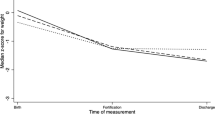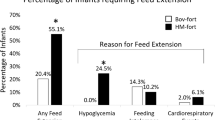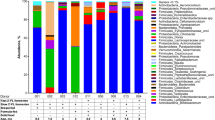Abstract
Background
Enteral nutrition supply to preterm infants requires feeding through a feeding tube. The aim of this study was to evaluate changes in macronutrient composition of human milk (HM) while passing through a gastric feeding tube.
Methods
Simulated real-life practice tube feeding was performed by using an infusion pump connected to a feeding tube. A human milk analyzer was used to compare the pre infusion and post infusion macronutrient contents of HM.
Result
There was a significant decrease in fat (from 4.06 ± 0.6 g/100 ml to 3.95 ± 0.6 g/100 ml), carbohydrates (from 7.51 ± 0.4 g/100 ml to 7.33 ± 0.5 g/100 ml), and energy content (from 70.77 ± 5.4 kcal/100 ml to 69.72 ± 0.5 kcal/100 ml) after passing through the feeding tube (P < 0.001).
Conclusion
A simulated real-life bolus tube feeding model demonstrated small but significant decreases in fat, carbohydrate, and energy content. The biological significance of our results to the very low birth weight infants should be further studied.
This is a preview of subscription content, access via your institution
Access options
Subscribe to this journal
Receive 12 print issues and online access
$259.00 per year
only $21.58 per issue
Buy this article
- Purchase on Springer Link
- Instant access to full article PDF
Prices may be subject to local taxes which are calculated during checkout

Similar content being viewed by others
References
McGuire W, Henderson G, Fowlie PW. Feeding the preterm infant. BMJ. 2004;329:1227–30.
Goswami I, Alshaikh B. Gavage feeding practices in VLBW infants: physiological aspects and clinical implications. Neoreviews. 2017;18:106–15.
Tacken KJ, Vogelsang A, van Lingen RA, Slootstra J, Dikkeschei BD, van Zoeren-Grobben D. Loss of triglycerides and carotenoids in human milk after processing. Arch Dis Child Fetal Neonatal Ed. 2009;94:447–50.
Buss IH, McGill F, Darlow BA. Vitamin C is reduced in human milk after storage. Acta Paediatr. 2001;90:813–5.
Ovesen L, Jakobsen J, Leth T. The effect of microwave heating on vitamin B1 and E, linoleic and linolenic acids and immunoglobulins in human milk. Int J Food Sci Nutr. 1996;47:427–36.
Igawa M, Murase M, Mizuno K, Itabashi K. Is fat content of human milk decreased by infusion? Pediatr Int. 2014;56:230–3.
Tabata M, Abdelrahman K, Hair AB, Hawthrone K, Chen Z, Abrams S. Fortifier and cream improve fat delivery in continuous enteral infant feeding of breast milk. Nutrients. 2015;7:1174–83.
Van Zoeren-Grobben D, Moison RMW, Ester WM, Berger HM. Lipid peroxidation in human milk and infant formula: effect of storage, tube feeding and exposure to phototherapy. Acta Paediatr. 1993;82:645–9.
Rogers SP, Hicks PD, Hamzo M, Veit LE, Abrams SA. Continuous feeding of fortified human milk lead to nutrient losses of fat, calcium and phosphorous. Nutrients. 2010;2:230–40.
Stocks RJ, Davies DP, Allen F, Sewell D. Loss of breast milk nutrients during tube feeding. Arch Dis Child. 1985;60:164–6.
Spencer SA, Hull D. Fat content of expressed breast milk: a case for quality control. Br Med J. 1981;282:99–100.
Castro M, Asbury M, Shama S, Stone D, Yoon EW, O’Connor DL, et al. Energy and fat intake for preterm infants fed donor milk is significantly impacted by enteral feeding method. J Parenter Enter Nutr. 2019;43:162–5.
Casadio YS, Williams TM, Lai CT, Olsson SE, Hepworth AR, Hartmann PE. Evaluation of a mid-infrared analyzer for the determination of the macronutrient composition of human milk. J Hum Lact. 2010;26:376–83.
Lev HM, Ovental A, Mandel D, Mimouni FB, Marom R, Lubetzky R. Major losses of fat, carbohydrates and energy content of preterm human milk frozen at −80 °C. J Perinatol. 2014;34:396–8.
Moran-Lev H, Mimouni FB, Ovental A, Mangel L, Mandel D, Lubetzky R. Circadian macronutrients variations over the first 7 weeks of human milk feeding of preterm infants. Breastfeed Med. 2015;10:366–70.
Lubetzky R, Sever O, Mimouni FB, Mandel D. Human milk macronutrients content: effect of advanced maternal age. Breastfeed Med. 2015;10:433–6.
Vohr BR, Poindexter BB, Dusick AM, McKinley LT, Wright LL, Langer JC, et al. Beneficial effect of breast milk in the neonatal intensive care unit on the developmental outcome of extremely low birth weight infants at 18 months of age. Pediatrics. 2006;118:e115–23.
Decsi T, Koletzko B. Polyunsaturated fatty acid in infant nutrition. Acta Paediatr. 1994;83:31–7.
Makrides M, Neumann MA, Byrad RW, Simmer K, Gibson RA. Fatty acid composition of brain, retina and erythrocytes in breast and formula fed infant. Am J Clin Nutr. 1994;60:189–94.
Author information
Authors and Affiliations
Contributions
DM, FBM, and RL conceptualized and designed the study and reviewed and revised the manuscript. HM-L and IZ designed the data collection instruments, collected data, carried out the initial analyses, drafted the initial manuscript, and reviewed and revised the manuscript. LM conceptualized and designed the study, coordinated and supervised data collection, and critically reviewed the manuscript for important intellectual content. All authors approved the final manuscript as submitted and agree to be accountable for all aspects of the work.
Corresponding author
Ethics declarations
Conflict of interest
The authors declare that they have no conflict of interest.
Ethics
This study was conducted according to the guidelines laid down in the Declaration of Helsinki and all procedures involving research study participants were approved by the Helsinki ethics committee. The study protocol was approved by the institutional review board of the medical center (0062-11). A signed written informed consent was obtained from all the participating mothers.
Additional information
Publisher’s note Springer Nature remains neutral with regard to jurisdictional claims in published maps and institutional affiliations.
Rights and permissions
About this article
Cite this article
Zommerfroind, I., Moran-Lev, H., Mandel, D. et al. Changes in macronutrients of human milk after bolus feeding: a simulation study. J Perinatol 41, 1069–1073 (2021). https://doi.org/10.1038/s41372-020-00899-2
Received:
Revised:
Accepted:
Published:
Issue Date:
DOI: https://doi.org/10.1038/s41372-020-00899-2



